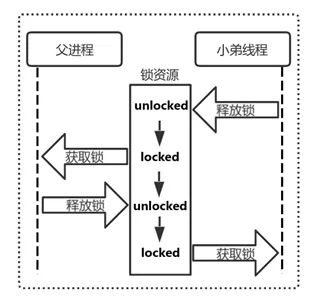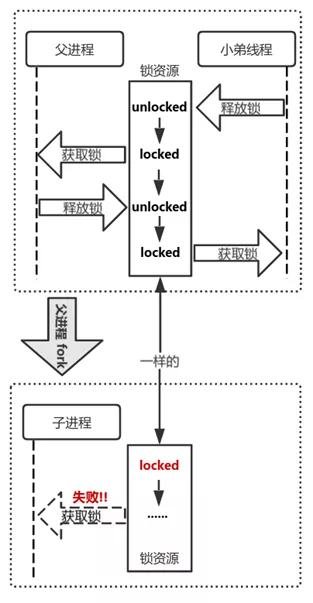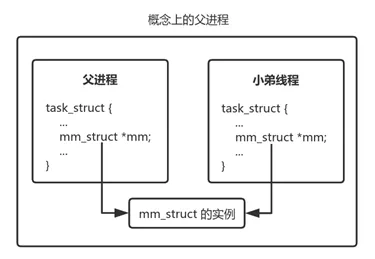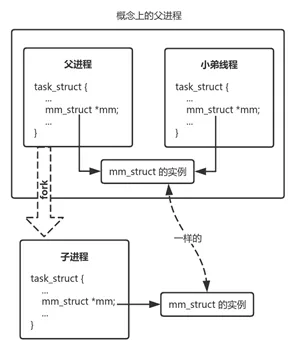[转载]大碰撞!当Linux多线程遭遇Linux多进程
本文转载自 Linux阅码场公众号 文章,原文链接:https://mp.weixin.qq.com/s/nWzWuNijWsriUgIenQol_g
作者简介#
廖威雄,目前就职于珠海全志科技股份有限公司从事linux嵌入式系统(Tina Linux)的开发,主要负责文件系统和存储的开发和维护,兼顾linux测试系统的设计和持续集成的维护。
拆书帮珠海百岛分舵的组织长老,二级拆书家,热爱学习,热爱分享。
背景#
本文并不是介绍Linux多进程多线程编程的科普文,如果希望系统学习Linux编程,可以看《Unix环境高级编程》第3版
本文是描述多进程多线程编程中遇到过的一个坑,并从内核角度分析其原理。这里说的多进程多线程并不是单一的多进程或多线程,而是多进程和多线程,往往会在写一个大型应用时才会用到多进程多线程的模型。
这是怎么样的一个坑呢?假设有下面的代码:
#include <stdio.h>
#include <unistd.h>
#include <pthread.h>
void *sub_pthread(void *unused)
{
printf("ID %d: in %s\n", getpid(), __func__);
sleep(1);
}
int main(int argc, char **argv)
{
int pid;
pthread_t ptid;
pthread_create(&ptid, NULL, sub_pthread, NULL);
if ((pid = fork()) < 0) {
printf("fork failed\n");
} else if (pid == 0) { /* children */
printf("ID %d (children)\n", getpid());
while(1);
} else { /* father */
printf("ID %d (father)\n", getpid());
while(1);
}
return 0;
}
童鞋们能分析出来,线程函数sub_pthread会被执行多少次么?线程函数打印出来的ID是父进程ID呢?还是子进程ID?还是父子进程都有?
答案是,只会执行1次,且是父进程的ID!为什么呢?
[GMPY@10:02 share]$./signal-safe
ID 6889: in sub_pthread
ID 6889 (father)
ID 6891 (children)
裤子都脱了,你就给我看这个?当然,这个没什么悬念,到目前为止还很简单。精彩的地方正式开始。
线程和fork#
在已经创建了多线程的进程中调用fork创建子进程,稍不注意就会陷入死锁的尴尬局面
以下面的代码做个例子:
#include <stdio.h>
#include <unistd.h>
#include <pthread.h>
pthread_mutex_t lock;
void *sub_pthread(void *unused)
{
while (1) {
pthread_mutex_lock(&lock);
printf("--- sub thread lock ---\n");
sleep(1);
pthread_mutex_unlock(&lock);
printf("--- sub thread unlock ---\n");
sleep(1);
}
pthread_exit(0);
}
int main(int argc, char **argv)
{
int pid;
pthread_t ptid;
pthread_create(&ptid, NULL, sub_pthread, NULL);
usleep(500);
if ((pid = fork()) < 0) {
printf("fork failed\n");
} else if (pid == 0) { /* children */
printf("children burn\n");
fflush(stdout);
while (1) {
pthread_mutex_lock(&lock);
printf("--- children lock ---\n");
sleep(1);
pthread_mutex_unlock(&lock);
printf("--- children unlock ---\n");
sleep(1);
}
} else { /* father */
while (1) {
pthread_mutex_lock(&lock);
printf("--- father lock ---\n");
sleep(1);
pthread_mutex_unlock(&lock);
printf("--- father unlock ---\n");
sleep(1);
}
while(1);
}
return 0;
}
执行效果如下:
[GMPY@10:37 share]$./test
--- sub thread lock ---
children burn
--- sub thread unlock ---
--- father lock ---
--- father unlock ---
--- sub thread lock ---
--- father lock ---
--- sub thread unlock ---
--- father unlock ---
--- sub thread lock ---
--- sub thread unlock ---
--- father lock ---
我们发现,子进程挂了,在打印了children burn后,没有了下文,因为在子进程获取锁的时候,死锁了!
凭什么啊?sub_pthread线程不是有释放锁么?父进程都能在线程释放后获取到锁,为什么子线程就获取不到锁呢?
在《Unix环境高级编程 第3版》的12.9章节中是这么描述的:(为了阅读方便,修改了段落排版)
子进程通过继承整个地址空间的副本,还从父进程那儿继承了每个互斥量、读写锁和条件变量的状态。
如果父进程包含一个以上的线程,子进程在fork返回以后,如果紧接着不是马上调用exec的话,就需要清理锁状态。
在子进程内部,只存在一个线程,它是由父进程中调用fork的线程的副本构成的。
如果父进程中的线程占有锁,子进程将同样占有这些锁。
问题是子进程并不包含占有锁的线程的副本,所以子进程没有办法知道它占有了哪些锁、需要释放哪些锁。
......
在多线程的进程中,为了避免不一致状态的问题,POSIX.1声明,在fork返回和子进程调用其中一个exec函数之间,
子进程只能调用异步信号安全的函数。这就限制了在调用exec之前子进程能做什么,但不涉及子进程中锁状态的问题。
究其原因,就是子进程成孤家寡人了。
每个进程都有一个线程,这个线程参与到任务调度,而不是进程,可以参考文章。

在上面的例子中,父进程通过pthread_create创建出了一个小弟sub_pthread,父进程与小弟之间配合默契,你释放锁我就获取,玩得不亦乐乎。

这时候,父进程生娃娃了,这个新生娃娃集成了父进程的绝大部分资源,包括了锁的状态,然而,子进程并没有共生出小弟,就是说子进程并没同时创建出小弟线程,他就是一个坐拥金山的孤家寡人。
所以,问题就来了。如果在父进程创建子进程的时候,父进程的锁被小弟sub_pthread占用了,fork生出来的子进程锁的状态跟父进程一样一样的,锁上了!被人占有了!因此子进程再获取锁就死锁了。
或者你会说,我在fork前获取锁,在fork后再释放锁不就好了?是的,能解决这个问题,我们自己创建的锁,所以我们知道有什么锁。
最惨的是什么呢?你根本无法知道你调用的函数是否有锁。例如常用的printf,其内部实现是有获取锁的,因此在fork出来的子进程执行exec之前,甚至都不能调用printf。
我们看看下面的示例:
#include <stdio.h>
#include <unistd.h>
#include <pthread.h>
#include <stdbool.h>
#include <sys/wait.h>
void *sub_pthread(void *unused)
{
printf("ID %d: in %s\n", getpid(), __func__);
while (true)
printf(" \r");
pthread_exit(0);
}
int main(int argc, char **argv)
{
pid_t pid;
pthread_t ptid;
int status;
pthread_create(&ptid, NULL, sub_pthread, NULL);
while (true) {
printf("fork\n");
if ((pid = fork()) < 0) {
printf("fork failed\n");
} else if (pid == 0) { /* children */
printf("ID %d (children)\n", getpid());
_exit(0);
} else { /* father */
printf("ID %d (father)\n", getpid());
waitpid(pid, &status, 0);
printf("ID %d exit\n", pid);
}
}
return 0;
}
上面的代码主要做了两件事:
- 创建线程,循环printf打印字符'\r'
- 循环创建进程,在子进程中调用printf打印字串
由于printf的锁不可控,为了加大死锁的概率,为fork套了一层循环。执行结果怎么样呢?
root@TinaLinux:/mnt/UDISK# demo-c
fork
ID 1684: in sub_pthread
ID 1684 (father)
ID 1686 (children)
ID 1686 (children) exit
fork
ID 1684 (father)
ID 1687 (children)
ID 1687 (children) exit
fork
ID 1684 (father)
结果在第3次fork循环的时候陷入了死锁,子进程不打印不退出,导致父进程wait一直阻塞。
上面的结果在全志嵌入式Tina Linux平台验证,比较有意思的是,同样的代码在PC上却很难复现,可能是C库的差异引起的
在fork的子进程到exec之间,只能调用异步信号安全的函数,这异步信号安全的函数就是认证过不会造成死锁的!
异步信号安全不再展开讨论,有问题找男人
man 7 signal
检索关键字Async-signal-safe functions
内核原理分析#
我们知道,Linux内核中,用task_struct表示一个进程/线程,嗯,换句话说,不管是进程还是线程,在Linux内核中都是用task_struct的结构体表示。
关于进程与线程的异同,可以看文章《线程调度为什么比进程调度更少开销?》,这里不累述。
按这个结论,我们pthread_create创建小弟线程时,内核实际上是copy父进程的task_struct,创建小弟线程的task_struct,且让小弟task_struct与父进程task_struct共享同一套资源。
如下图

在父进程pthread_create之后,父进程和小弟线程组成了我们概念上的父进程。什么是概念上的父进程呢?在我们的理解中,创建的线程也是归属于父进程,这是概念上的父进程集合体,然而在Linux中,父进程和线程是独立的个体,他们有自己的调度,有自己的流程,就好像一个屋子下不同的人。
父进程fork过程,发生了什么?
跟进系统调用fork的代码:
SYSCALL_DEFINE0(fork)
{
return _do_fork(SIGCHLD, 0, 0, NULL, NULL, 0);
}
long _do_fork(...)
{
......
p = copy_process(clone_flags, stack_start, stack_size,
child_tidptr, NULL, trace, tls, NUMA_NO_NODE);
......
}
/*
* This creates a new process as a copy of the old one,
* but does not actually start it yet.
*
* It copies the registers, and all the appropriate
* parts of the process environment (as per the clone
* flags). The actual kick-off is left to the caller.
*/
static __latent_entropy struct task_struct *copy_process(...)
{
......
}
嗯...只是copy了task_struct,怪不得fork之后,子进程没有伴生小弟线程。所以fork之后,如下图:
(为了方便理解,下图忽略了Linux的写时copy机制)

Linux如此fork,这与锁有什么关系呢?我们看下内核中对互斥锁的定义:
struct mutex {
/* 1: unlocked, 0: locked, negative: locked, possible waiters */
atomic_t count;
spinlock_t wait_lock;
struct list_head wait_list;
......
};
一句话概述,就是 通过原子变量标识和记录锁状态,用户空间也是一样的做法。
变量值终究是保存在内存中的,不管是保存在堆还是栈亦或其他,终究是(虚拟)内存中某一个地址存储的值。
结合Linux内核的fork流程,我们用这样一张图描述进程/线程与锁的关系:





【推荐】国内首个AI IDE,深度理解中文开发场景,立即下载体验Trae
【推荐】编程新体验,更懂你的AI,立即体验豆包MarsCode编程助手
【推荐】抖音旗下AI助手豆包,你的智能百科全书,全免费不限次数
【推荐】轻量又高性能的 SSH 工具 IShell:AI 加持,快人一步
· 如何编写易于单元测试的代码
· 10年+ .NET Coder 心语,封装的思维:从隐藏、稳定开始理解其本质意义
· .NET Core 中如何实现缓存的预热?
· 从 HTTP 原因短语缺失研究 HTTP/2 和 HTTP/3 的设计差异
· AI与.NET技术实操系列:向量存储与相似性搜索在 .NET 中的实现
· 周边上新:园子的第一款马克杯温暖上架
· Open-Sora 2.0 重磅开源!
· 分享 3 个 .NET 开源的文件压缩处理库,助力快速实现文件压缩解压功能!
· Ollama——大语言模型本地部署的极速利器
· DeepSeek如何颠覆传统软件测试?测试工程师会被淘汰吗?